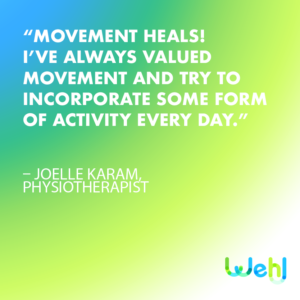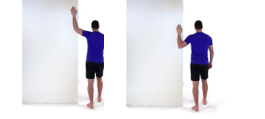Our bodies have incredible capacities to heal themselves through movement. When we’re stationary for too long, or exhibiting poor posture, it’s not uncommon for us to develop tension and feel stiff. To understand more about how physiotherapy can help us prevent injury and maintain our bodies, we connected with Physiotherapist Joelle Karam. Joelle operates an integrative performance therapy practice in Toronto, Ontario where she loves to assist individuals to meet their health and fitness goals. Joelle provides functionally based treatment, tailored to the individual, to maximize the body’s potential.
We connected with Joelle to understand how physiotherapy can be used to help maintain our bodies and prevent injury, why posture and breathing are important, and how we can minimize tension through simple, daily exercises.
 WEHL: Tell us a little about yourself and what made you want to become a Physiotherapist.
WEHL: Tell us a little about yourself and what made you want to become a Physiotherapist.
JK: I’ve always wanted to be in healthcare. I grew up playing sports and gravitated towards subjects like biology and exercise science in high school. When I needed physiotherapy myself, for a running injury, I saw first hand how much physios know about our bodies and how much they can help us understand our bodies, our injuries and empower us to stay healthy. While in university I had some volunteer experience in a sport medicine clinic and orthopaedic rehab clinic which opened my eyes to all that physiotherapists have to offer in helping people keep moving through all stages of life. These experiences made me want to learn and know as much as they knew about the human body and be able to offer the same kind of services to my community.
WEHL: What’s your personal philosophy on wellness?
JK: Movement Heals! I’ve always valued movement and try to incorporate some form of activity every day. Some days I get a workout in, some days I get to walk to or from work and some days I only have time to take the stairs a couple flights to get in and out of the condo. Regardless of how busy I am, I know I always feel good after a bit of movement and try to make it a part of my day to day. I encourage this of all my patients as well, while I do load them up with exercises to do at home I also tell them that something is better than nothing and even if they feel like they have no time, try for just one exercise before work, during lunch or before bed.
 WEHL: Do you have one wellness-related tip or insight that has helped you in your own personal wellness journey that you could share?
WEHL: Do you have one wellness-related tip or insight that has helped you in your own personal wellness journey that you could share?
JK: Overall wellness is a dynamic balance from the inside out. How we fuel ourselves physically and mentally is what drives our overall wellness. While I value movement for physical health, if our insides aren’t healthy then our ability to positively respond to movement is compromised. What I’ve found works best for me is ensuring I stay on top of my food intake and mental wellbeing. I try to keep up with a lifestyle of well-rounded meals, which fluctuates from 2-3 meals per day or grazing with intermittent fasting incorporated every few weeks or once a month. For my mental wellbeing I allow myself downtime to help my body and my mind rest and reset after interacting with people all day and doing something good for my mind, whether it be reading or meditating or journaling a gratitude or positive thought for the day.
Everyone’s strategy is different and I think there is some trial and error to find what works best for you. I’ve found trying to incorporate some strategies more stressful than others, which defeats the purpose of the pursuit for wellness. So my suggestion is to try out different things for some period of time and see what sticks for you.
WEHL: We often think of physiotherapy as only being needed after an injury, surgery, or once we’ve been dealing with chronic pain and stiffness for a while. How can physiotherapy also be used proactively for maintenance, prevention and generally improving our wellness?
JK: Physiotherapy uses various techniques including soft tissue release, mobilization of connective tissue and joints, exercises and modalities such as acupuncture to maintain and promote adaptability of the body and good movement variability*, i.e. the ability to achieve a task in various ways and access various ranges of movement. It is when we lose variability and adaptability that we put ourselves at risk of injury.
Most people seek out physio when they’ve lost their ability to achieve a certain task (like putting a jacket on, brushing their hair, throwing a ball or lifting weights) or if they are experiencing pain. At this point the body has already adapted in many ways to help you achieve your movement goals and has now failed, which means the body has lost its movement variability and adaptability, so the work in trying to restore these characteristics and achieve the movement goals becomes harder. If someone was seeking physiotherapy regularly, say as often as they get their cars in for an oil change, rather than reactively trying to restore what they once had, they would be less likely to lose it in the first place.
*I came to appreciate movement variability and adaptability under the guidance of my mentor who leads the McMaster Contemporary Acupuncture Program.
WEHL: Many of us are no stranger to tightness in our upper bodies. What are some of the main causes of neck, shoulder and upper back tension?
JK:
Posture!
- The way we sit or stand at our computer desks (yes standing desks also create issues), our tablets, or cellphones – it’s not only about the fact that most people hunch forward or poke their chins out at the computer but that they do this for long periods of time. We aren’t meant to be in any posture for any length of time and it is to our benefit to move regularly throughout the day. Even just getting up and taking a quick walk around the office, moving the head and neck around and reaching arms up overhead a few times is enough to help combat the tension we develop in our upper body (do this at least every hour you are at your desk!)
Other places to think about posture include:
- The way we sit to eat
- Sitting or lying on the couch
- While driving – bucket seats and improper seat/steering wheel set up encourage a slouched and forward head posture, think sitting tall in the car as well, and if needed place a small pillow or rolled towel behind your back
Stress is another huge factor that plays into neck, shoulder and upper back tension. Many people, if not all, who come into my clinic for treatment will say that they carry all their stress there. Stress management is something we all need not only for tension but for overall wellness as chronic stress negatively affects our whole system. Diaphragmatic breathing (belly breathing) is one great way to steer tension away from the neck and shoulders and also calm our nervous system which helps to relieve the effects of stress on the body.
WEHL: How can we work to minimize and prevent neck, shoulder and upper back tension?
JK:
- Regular movement throughout the day, in ranges that are different that your day to day posture (i.e. lift arms overhead, make circles with the arms, get into some deep squatting, gently get into some twisting movements of the neck and back as well as side to side bending, etc)
- Slow and deep belly breathing to help steer tension away from the neck and shoulders and calm your whole system (stress also creates shallow breaths which then puts the work of breathing on the muscles of the neck, shoulder and upper back, adding to tension)
WEHL: Do you have any exercises or stretches that we could do during our workday to help?
JK: Thinking from the top down – start with sitting tall and tucking the chin in slightly, tilt the shoulder blades back and hold.
Neck Movements:
- Move your head to look up and down side to side (over your shoulders), and side bend ear toward your shoulder (don’t shrug the shoulder up). 10 times in each direction.
Shoulder Movements:

-
- Roll the shoulders forward and back like you are drawing circles with the tip of the shoulder – make sure you roll as much backwards as you do forward. 10 times in each direction

-
- Stretch the arms out to the side and draw big circles with your arms forward and backward. 10 times in each direction

-
- Bend the elbows so palms are facing forward, elbows at shoulder height and press the arms up and down keeping them in line with the side of your body (don’t let them come forward). 10 reps

-
- Pec Stretch – have the arm below or above shoulder height to stretch different parts of the muscle. Hold for 5 breaths each.
Upper Back
- Squeeze shoulder blades together like you are pinching a pencil between them then round them forward and breathe into the space between them- 10 times in each direction (think cat – cow but in sitting)
- Cross your arms over your chest then rotate your torso as far as you can side to side without letting your hips twist. Exhale as you rotate and inhale to come back to centre. 10 times in each direction.
Image source: Physiotech
WEHL: How does our breathing relate to neck and upper back tension?
JK: Breath has a huge influence on our entire body. Short “apical” breaths or high chest breathing, puts a lot more of the work of breathing into the muscles of the neck and shoulders. Because we breathe all day, if these muscles are driving our breath then they are working all day and slowly tightening over time. This also tells our body that we should be in a state of “fight of flight” or otherwise a state of stress, which results in a protective posture of shrugged shoulders and shortening through the neck and upper back – think turtle shrinking into its shell.
WEHL: Do you have a breathing exercise you can share with us to help relieve tension?
JK: One of the best ways to help train proper breathing techniques which can alleviate tension and calm the whole nervous system is to find a comfortable position (sitting or lying down) and place one hand on the belly and one on the chest. While focusing on your breath think about allowing only the hand over the belly to move – gently rising with inhale and lowering with exhale – nothing should be forced and the breath should be slow, going for length of time in each cycle of breath – try for 5 seconds of inhale and 5 seconds of exhale (counted as slow as possible!). Once you have this down, we can bring the ribs back into the breath by thinking of expanding the ribcage while allowing the belly to rise. It’s nice to have a hand on the side of the ribs to feel that movement as well. It sounds like a lot to think about at first but with a little practice it can become your natural way of breathing and can help minimize the build up of tension in the upper body.
You can read a bit more about this on my blog here.
WEHL: We’re often taught growing up to straighten up and put our “shoulders back”. What does “good posture” look like in the upper body and how can we practice it throughout our day?
JK: I write about this on my blog as well: click here. What I see often when I ask clients to set their shoulders and show me good posture is more of puffing of the chest and over extension of the mid to low back, (think Tarzan) . I will also see a leaning back of the whole torso. What I try to encourage instead is to think of a string coming up from the crown of the head that someone is pulling on to lengthen the spine. You want to keep your body weight on and slightly in front of your “sit bones” if you are sitting and the shoulder blades are slightly up and back – like there is a fish hook behind you that you are trying to hang your shoulder on. Then try to hold this position while breathing 5-10 belly breaths.
I’ve suggested in the past to set an alarm on your phone or computer to go off and remind you to correct your posture. Or set a goal that every time the phone rings in your office you correct your posture before answer and try to maintain it during the call, or every time someone comes into your office, you correct and maintain your posture. Think of something that happens often while at the office and make it your trigger to remind yourself of your posture.
 WEHL: What might a physiotherapy treatment include for general stiffness in the neck and shoulders due to activities like computer work?
WEHL: What might a physiotherapy treatment include for general stiffness in the neck and shoulders due to activities like computer work?
JK: Treatment with me will include a combination of soft tissue work of the muscles and connective tissue of the neck, shoulders and back as well as education regarding posture and exercises specific to the individual to help create a better muscle balance between the front and back of the body. I will use a combination of breath practice, body weight exercises, bands or weights to develop a posture re-training program that the client can take home with them. I will often incorporate contemporary acupuncture methods to help improve blood flow to the tissue we are targeting, to help the muscles relax and ultimately relieve any tension or pain felt by the client.
Many physiotherapists use both manual therapy techniques, modalities like acupuncture, and exercises to help alleviate symptoms and then train the individual to prevent future occurrences.
WEHL: Do you have any tips for someone who wants to see a Physiotherapist for the first time?
JK: Come properly dressed for the area we will be working on. We will want to see the area clearly which often means exposing that area. For the neck, shoulder, upper back areas a loose top or tank top or sports bra for the ladies is ideal and I will often ask males to remove their top if they are comfortable with that. Not all clinics have gowns available so it is best to think ahead and bring something you are comfortable being in, can move freely in and allows the therapist the best access to the area of interest.
Try to think about the pattern of your symptoms and maybe track them for the week or two leading up to your treatment so that you have an idea of how your injury is trending. I find memory and reality can be a bit skewed so if you can jot down a few notes so you have an objective measure of what’s happening that helps both of us get an idea of what is going on.
It is normal to feel that you’ve been worked on after a visit. We will be asking you to move and we will touch and move certain limbs and joints based on the area of pain. We may reproduce your pain during the session with some of these movements as well.
Initial assessments are a chance for you and the physio to meet and start to gain an understanding of why you are there and what your goals are so we can work on achieving these goals together. There is usually some paperwork to fill out and you may need to change to have the area we are working on readily available. Keep that in mind when booking and travelling to your appointments so you can make the most of the time you have with the therapist.
Connect with Physiotherapist Joelle Karam:
- Web: https://www.joellekarampt.com
- Email: [email protected]
- Wehl Platform: @joellekarampt
We invite you to join our all-in-one healthy lifestyle app at Wehl.com!
How do you prevent and manage tension in your body? Share with us below!




1 Comment
Sherika
Great article.. I often suffer from tension and stiff muscles especially in my upper body. These tips were very useful and I will definitely try them.